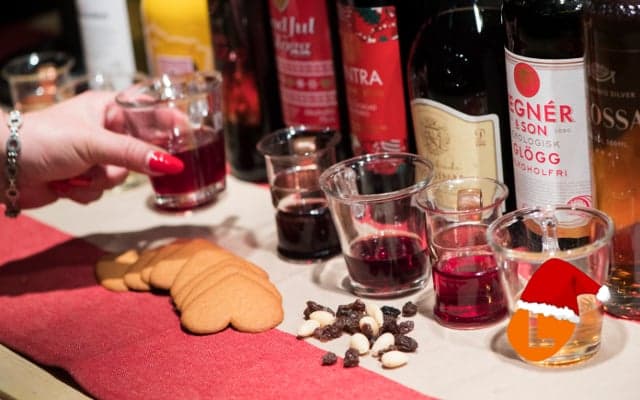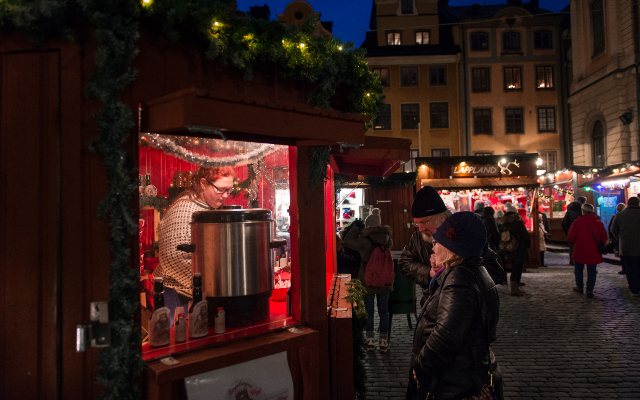#SwedishChristmas: How glögg sends Swedish wine consumption through the roof

Every day until Christmas Eve, The Local explains the unique history behind Swedish Christmas traditions in our own Advent calendar.
Throughout most of the year, Swedes drink relatively little wine, especially compared to the Portuguese, French, Swiss and Croats, just to name a few. But that suddenly changes as the first bottles of glögg (Swedish mulled wine) start lining the shelves of supermarkets and Systembolagets, signalling that Christmas is drawing near.
The swift proliferation online and in stores of glögg paraphernalia, such as little bags of raisins mixed with blanched almonds, and all manner of glögg mugs, glasses, and carafes with built-in warmers, removes any lingering doubts about how deeply ingrained and popular the drink is at Christmas in Sweden.
Each Christmas, Swedes drink around five million litres of glögg, according to the Stockholm Spritmuseum. And yet glögg – which is simply heated wine infused with a variety of ingredients known collectively as mulling spices – has only been a Christmas tradition in Sweden since the late 19th century. It's also not at all special to Sweden. Mulled wine dates back to ancient Greece and Rome, and was introduced to much of Europe by Roman invaders and settlers. In the same way, mulled wine was brought to the New World. As a result, some type of mulled wine exists everywhere from Chile to Lithuania and from Moldova to Canada.

Glögg being served at a Christmas market in Gamla Stan, Stockholm. Photo: Stina Stjernkvist/TT
In Sweden, during the first half of the 16th century, a type of mulled wine was a favoured drink of Sweden's King Gustav Vasa, and the drink became increasingly popular from the 17th century on, appearing increasingly in cookbooks throughout the 1800s. But while glögg was a popular beverage during the cold months, it owes its association with Christmas in Sweden to a new awareness in the 1890s of the power of brands and packaging.
"Glögg became closely associated with winter and the chilly weather, along with Advent and Christmas, thanks to Swedish winemakers of the late 19th century and their successful marketing efforts," explained Eva Lenneman, curator at the Stockholm Spritmuseum. "They aimed to reinstate an old drinking tradition that had begun decline in popularity and was seen as old fashioned. Labelling created a great opportunity to connect the commercial visual language of little elves in red costumes and winter wonderland landscapes with the product and season".
This strategy was so successful that glögg is now almost exclusively a Christmas beverage. The Systembolaget website shares a statistic that illustrates this perfectly: "The week before Christmas 2016, Systembolaget sold 532,000 litres of glögg. A week later, [only] 35,000 litres were sold." And just like that, Swedish wine consumption returns to normal levels.
Comments
See Also
Throughout most of the year, Swedes drink relatively little wine, especially compared to the Portuguese, French, Swiss and Croats, just to name a few. But that suddenly changes as the first bottles of glögg (Swedish mulled wine) start lining the shelves of supermarkets and Systembolagets, signalling that Christmas is drawing near.
The swift proliferation online and in stores of glögg paraphernalia, such as little bags of raisins mixed with blanched almonds, and all manner of glögg mugs, glasses, and carafes with built-in warmers, removes any lingering doubts about how deeply ingrained and popular the drink is at Christmas in Sweden.
Each Christmas, Swedes drink around five million litres of glögg, according to the Stockholm Spritmuseum. And yet glögg – which is simply heated wine infused with a variety of ingredients known collectively as mulling spices – has only been a Christmas tradition in Sweden since the late 19th century. It's also not at all special to Sweden. Mulled wine dates back to ancient Greece and Rome, and was introduced to much of Europe by Roman invaders and settlers. In the same way, mulled wine was brought to the New World. As a result, some type of mulled wine exists everywhere from Chile to Lithuania and from Moldova to Canada.

Glögg being served at a Christmas market in Gamla Stan, Stockholm. Photo: Stina Stjernkvist/TT
In Sweden, during the first half of the 16th century, a type of mulled wine was a favoured drink of Sweden's King Gustav Vasa, and the drink became increasingly popular from the 17th century on, appearing increasingly in cookbooks throughout the 1800s. But while glögg was a popular beverage during the cold months, it owes its association with Christmas in Sweden to a new awareness in the 1890s of the power of brands and packaging.
"Glögg became closely associated with winter and the chilly weather, along with Advent and Christmas, thanks to Swedish winemakers of the late 19th century and their successful marketing efforts," explained Eva Lenneman, curator at the Stockholm Spritmuseum. "They aimed to reinstate an old drinking tradition that had begun decline in popularity and was seen as old fashioned. Labelling created a great opportunity to connect the commercial visual language of little elves in red costumes and winter wonderland landscapes with the product and season".
This strategy was so successful that glögg is now almost exclusively a Christmas beverage. The Systembolaget website shares a statistic that illustrates this perfectly: "The week before Christmas 2016, Systembolaget sold 532,000 litres of glögg. A week later, [only] 35,000 litres were sold." And just like that, Swedish wine consumption returns to normal levels.
Join the conversation in our comments section below. Share your own views and experience and if you have a question or suggestion for our journalists then email us at [email protected].
Please keep comments civil, constructive and on topic – and make sure to read our terms of use before getting involved.
Please log in here to leave a comment.